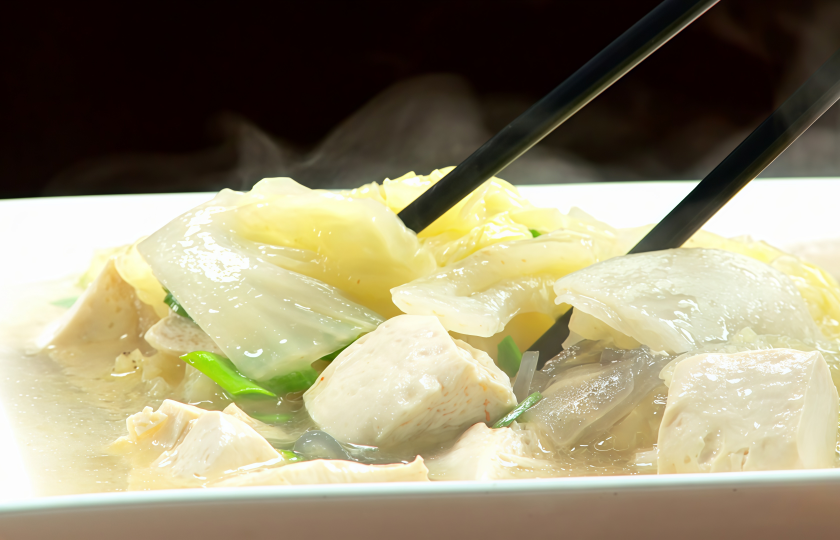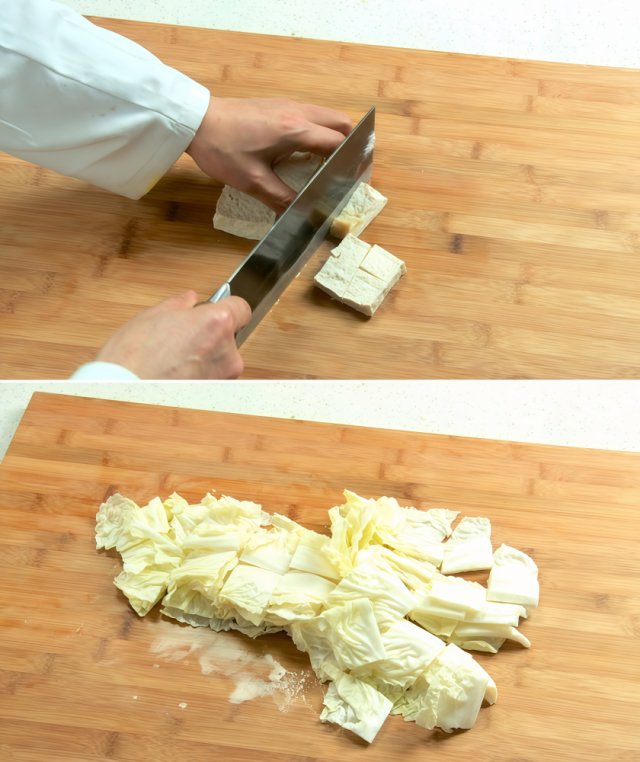Chinese Braised Cabbage with Tofu


In Chinese cuisine, the simplest ingredients often create the most comforting dishes. Braised cabbage with tofu exemplifies how humble components can transform into a nourishing masterpiece.
Why do you like this dish?
It's simple, delicious and extremely filling.
It is nutritionally rich, being abundant in protein and fiber.
An easily customizable recipe - you can freely use other vegetables or seasonings!
It's cost-effective and only requires simple ingredients.
Tofu Options
Regular soft tofu is used in this dish. After stewing, it has a delicate texture and absorbs the sauce well, making it extremely flavorful. If you prefer a different texture, you can also switch to:
Firm tofu: It has a more compact texture and is less likely to break, making it suitable for those who like a chewier texture.
Gypsum tofu (nigari tofu): It has the tenderest texture but is prone to breaking, suitable for scooping gently and eating.
Fried tofu puffs: They have pores of their own and absorb the soup especially well. Just put them in at the end and let them simmer for a while.
Dried bean curd sticks (either strip-shaped or knot-shaped): Soak them in advance and add them together with the wide glass noodles during cooking. They are more resistant to boiling and have a very elastic texture.

Main Ingredients and Substitutes
Tofu
It is recommended to use cubed tofu for this dish. If you prefer a firmer texture that is less likely to break, you can choose medium-firm or extra-firm tofu. If you like a smoother and more delicate texture, soft tofu is also a good option, but be careful not to choose it too soft!
Napa Cabbage
Napa cabbage is used in the recipe, including both the tender leaves and the crunchy stalks. If you don't have napa cabbage at home, you can try baby cabbage, bok choy, or cabbage. They will also work well.
Wide Glass Noodles
Wide glass noodles can soak up the soup and add chewiness. If you don't have them, you can use wide vermicelli or sheets of dried tofu skin as substitutes. The flavor will be a bit different, but they are still good choices.
Green Onion, Ginger, and Garlic
These are the keys to making the stir-fry fragrant. If you don't have garlic leaves on hand, minced garlic will also do. Green onion and ginger can also be flexibly replaced, such as using onions or ginger root.
Seasonings
Basic seasonings like cooking wine, salt, and sesame oil are usually available at home. You can adjust them according to your own taste.
INGREDIENTS
Main Ingredients
-
·200g Tofu (cut into uniform cubes)
-
·500g Napa cabbage (break off the leaves, wash clean, and separate the cabbage stalks from the leaves)
Additional Ingredients
-
·10g Green onion (cut into sections)
-
·10g Ginger (sliced)
-
·20g Garlic leaves (cut into sections)
-
·300g Wide glass noodles (soaked in advance)
-
·15ml Cooking oil
Seasonings
-
·5ml Cooking wine
-
·5g Salt
-
·300ml Water
-
·3ml Sesame oil
COOKING STEP
Step 1
Cut the tofu into uniform cubes and set aside. Break off the leaves of the napa cabbage, wash them clean, and cut the cabbage stalks and leaves into pieces separately.

Step 2
Cut the green onion into sections, slice the ginger, and cut the garlic leaves into sections, then set them aside.

Step 3
Pour 15ml of cooking oil into a pot. After it gets hot, add the ginger slices and green onion sections, and stir-fry over high heat for 5 seconds until fragrant.

Step 4
First, add the cabbage stalks and stir-fry until softened, then add the cabbage leaves and stir-fry until the whole becomes soft and juicy.

Step 5
Pour 5ml of cooking wine along the edge of the pot, add 5g of salt, and pour in 300ml of water (the water level should cover about 2/3 of the cabbage).

Step 6
After the water boils, gently put in the tofu cubes. Shake the pot to ensure even heating, then cover the pot and simmer over low heat for 5 minutes.

Step 7
Add 300g of the soaked wide glass noodles, cover the pot and continue to cook for 3 minutes until the noodles become transparent.

Step 8
Sprinkle with the cut garlic leaves, drizzle 3ml of sesame oil, turn off the heat, stir well, and then serve.

More recipes worth trying
Chinese Herbal Chicken Soup Recipe
Practical Tips
Selection of Cookware
It is better to use a large wok or a deep frying pan so that the ingredients can be heated evenly and the stir-fried cabbage can release its juice more easily.
Sequence of Stir-frying Cabbage
Stir-fry the cabbage stalks first, and then add the leaves. This way, the tougher parts can soften first, and then the tender leaves can absorb the soup, resulting in a more harmonious taste.
Handling of Tofu and Wide Glass Noodles
After adding the tofu, remember to gently shake the pot to ensure even heating. Don't cook the wide glass noodles in the pot for too long; 3 minutes is enough to keep them transparent and elastic.
Control of Heat
After it boils, cover the pot and simmer over low heat. This way, the tofu can absorb the flavors fully and is less likely to break, achieving better results.
Other Variations of the Recipe
You can try these variations to give a new twist to the classic Cabbage Stewed with Tofu:
Sour and Spicy Flavor
After stir - frying the cabbage until soft, add half a spoonful of white pepper powder and pour in 1 spoonful of balsamic vinegar. Before serving, sprinkle a handful of chopped pickled peppers. The soup is sour, spicy with a slight pungency, which pairs well with rice.
Seafood - Enhanced Version
Use shrimp heads to stir - fry for oil to replace part of the cooking oil. Replace the tofu with tender fish slices. Throw in a few fresh scallops before the wide glass noodles are cooked through. The soup naturally has the fresh and sweet taste of the ocean.
Creamy and Milky Version
Heat the pan and first stir - fry the cabbage stalks with lard. Replace the water with bone broth. Fry the tofu until golden brown and then stew. Finally, add half a cup of milk. The soup is milky white and highly fragrant.
Spicy Dry - Pot Version
Stir - fry the cabbage until it is half - soft and then take it out. Heat another pan and sauté dried chili peppers and Chinese prickly ash until fragrant. Put all the ingredients back into the pan, add 1 spoonful of broad bean chili paste, and stir - fry without adding water until the sauce thickens.
Simplified Version without Wide Glass Noodles
Omit the wide glass noodles. After stewing the cabbage until soft, add a light cornstarch slurry (1 spoonful of starch + 2 spoonfuls of water). Coat the surface of the tofu with starch and fry it until set. The soup will be thicker and easier to coat the spoon.
Winter Hot Pot
Operate directly in a clay pot. Place the cabbage at the bottom, then layer the tofu and wide glass noodles. Add water until it is 80% full. Simmer over medium - low heat for 15 minutes, sprinkle with goji berries and serve.
How to Enjoy
Here are some suggestions for pairing and garnishing when enjoying this dish:
Simple Garnish
Before serving, sprinkle some green onion or garlic leaves, and then drizzle a few drops of sesame oil. If you like a bit of spiciness, you can also add a little chili oil to add a touch of zest to the dish.
Staple Food Pairings
Serve this dish with hot white rice. The sauce can fully soak into the rice grains, making the taste more intense. You can also try pairing it with noodles or fried rice; they are all great options.
Pairings with Other Dishes
If you want to make the meal more substantial, pair it with some refreshing side dishes or Chinese appetizers, such as cold cucumber salad or simple vegetable spring rolls. This will not only whet your appetite but also make the meal more balanced.
Enjoying with the Soup
This dish has plenty of sauce. Don't forget to enjoy the soup while eating the food; it will make the whole meal more satisfying!
FAQs:
The appearance of the dish may not be as fresh as when using napa cabbage, but it still tastes good.
Try to avoid excessive stirring during cooking. You can gently turn the tofu over with a spatula to ensure it remains intact during the stewing process.
If you need to add other ingredients, it is recommended to add them at the end to avoid overcooking.
If you want to keep the cabbage leaves tender, it is best to add some hot soup before reheating.

















